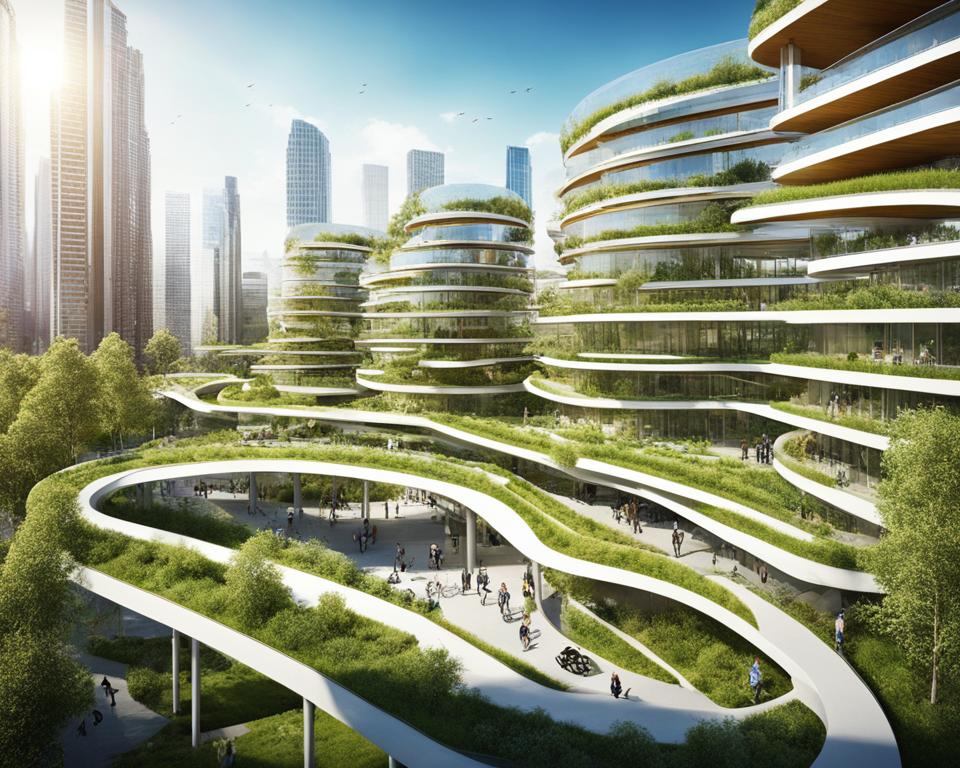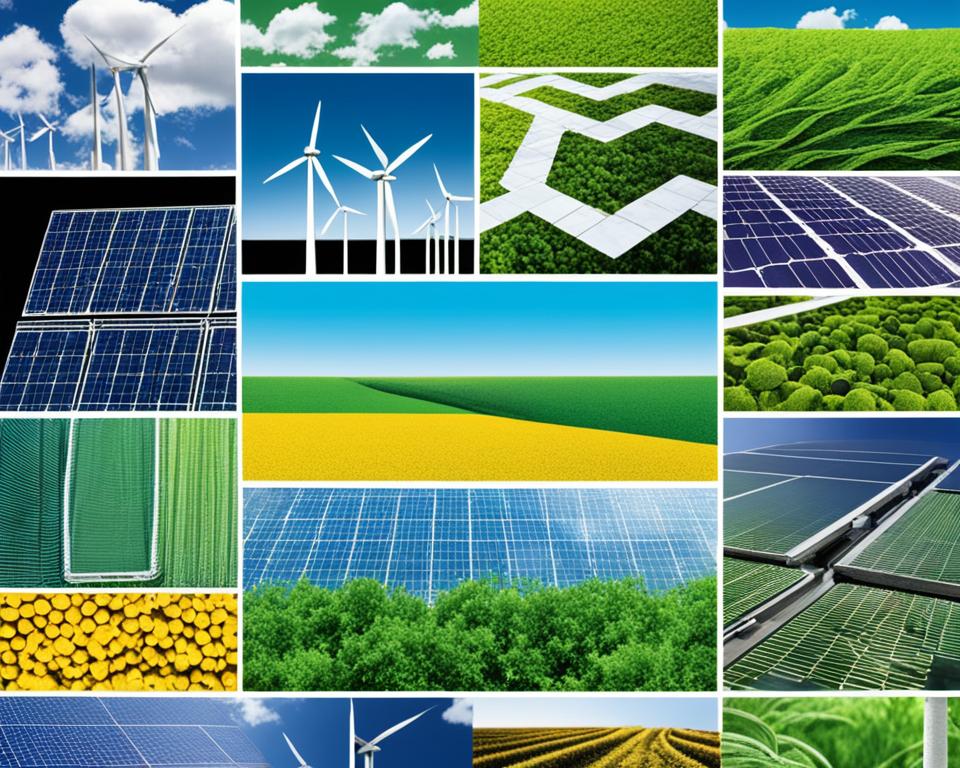Sustainable Materials and Technologies for a Greener Future

The world is facing tough environmental issues. So, it’s focusing on new and sustainable materials and technologies. This article looks at advanced ideas to cut down on harm to the planet, save natural resources, and push for a circular economy. It covers everything from renewable resources to ways of making things that are better for the environment.
At the core of this change is the idea that we must think about the planet. We can do this by using sustainable materials and technologies. These tools help us use less of Earth’s resources and work towards a circular economy. This means we make the most of everything we have. With new ways of making things and using materials, we’re setting up a world that won’t harm the planet.
We also look closely at these new materials and how they affect the Earth over time. We talk about the good and the hard parts of using these eco-friendly options. And we see what’s next if we choose to keep going down this path.
Working in the area of sustainable materials and technologies is key. We have to keep on creating and working together. By focusing on clean technologies and materials from nature, we can make a brighter future for everyone.
Read interesting things at : intarajyuku
Key Takeaways
- Sustainable materials and technologies are essential for addressing pressing environmental challenges and transitioning towards a circular economy.
- Renewable resources, biomaterials, and eco-friendly manufacturing processes play a crucial role in reducing environmental impact.
- Life cycle analysis and carbon footprint calculations are vital for evaluating the true sustainability of materials and technologies.
- Overcoming barriers to adoption and incentivizing sustainable practices are key to driving widespread change.
- Collaborative efforts and innovative solutions are shaping the future of sustainable materials and technologies.
Introduction to Sustainable Materials and Technologies
Right now, the world faces big environmental issues. So, we need to really get into sustainability. By using sustainable materials and technologies, we can lessen the effect of our actions on Earth. This can help lead us to a future that’s much greener. We’ll talk about why we should use eco-friendly innovations and how they make a circular economy possible.
Why We Need to Embrace Sustainability
Our current way of making and using things is hurting the environment a lot. This happens when we take, make, and then throw things away. It uses up our natural resources, makes a lot of waste, and makes climate change worse. To fix this, we need to aim for a circular economy. This means we try to use less, throw away less, and lower our harm on the planet.
The Importance of Eco-Friendly Innovations
Using green materials and technologies is key to a better future. They let us use more renewable resources, make things from plants, and use eco-friendly ways to make products. This way, we aren’t relying so much on things that will run out. Plus, it helps build a circular economy where we keep reusing and recycling stuff. This means less waste and smarter use of resources.
Renewable Resources for a Circular Economy
The world is running out of natural resources fast. This is pushing us towards finding sustainable solutions. The goal is a circular economy, where we use materials for as long as we can. This approach cuts down on waste and reduces the need for new resources.
Harnessing the Power of Biomaterials
Biomaterials are leading the way to a circular economy. These materials come from renewable sources. Things like bioplastics, biocomposites, and products made from cellulose are great examples. They’re eco-friendly because they break down easily, can be composted, or recycled.
Ecovative Design is one company making big strides with biomaterials. They’ve developed materials from mycelium that rival traditional materials like plastic and wood. What’s more, these materials work well in many different uses.
Recycling and Upcycling Initiatives
Recycling and upcycling are key in shifting to a circular economy. These efforts keep items in use longer. This cuts down waste and lessens the need for new resources.
The Cradle to Cradle Certified program is a great example. It sets standards for products that can safely go back into the earth or cycles of production. This means companies can do better for the planet while discovering new business and making unique products.
Green Manufacturing Processes
Green manufacturing is changing our future for the better. It’s all about making things without hurting the planet. This way, we use fewer materials, keep our world cleaner, and help keep things in a loop.
Using energy wisely is a big part of green manufacturing. We tap into the sun and wind to power our factories. Plus, we use machines and systems that don’t waste energy.
Choosing the right materials is also important. We’re now picking materials that are easy to find again or that come from living things. This switch makes what we make kinder to our planet in the long run.
Embracing new technologies is a key step too. Things like smart machines and computers make production smarter. This lets us make exactly what’s needed with less left over.
All these efforts mean industries can change for the better. They can make products the Earth loves too. We’re moving towards a world where we do more with less harm, thanks to new ways of making things.
Clean Technologies: Reducing Environmental Impact
The world is quickly focusing on looking after our planet. This means the use of clean technologies is more important than ever. These technologies work to make the way we do things less harmful to the Earth. This helps us move towards a future that is better for everyone.
Energy-Efficient Solutions
Leading the clean tech charge are solutions for saving energy. They lower how much energy we use and cut down on the harmful gases we put into the air. You see this in things like solar power, wind power, and even saving energy in our homes and cities. These steps are big in making our world cleaner and greener.
Water Conservation Strategies
Aside from saving energy, clean tech is also tackling the problem of not having enough water. It includes systems to clean and reuse water, along with smart ways to water fields. By using these methods, we can use less water and keep it clean. This makes sure we have enough water to go around and protects the environment.
| Clean Technology | Benefits | Key Applications |
|---|---|---|
| Renewable Energy Systems | Reduced greenhouse gas emissions, increased energy independence, and long-term cost savings | Residential, commercial, and industrial sectors |
| Advanced Water Treatment Systems | Improved water quality, reduced water waste, and conservation of water resources | Municipal water treatment, industrial processes, and agricultural irrigation |
| Energy-Efficient Building Technologies | Lower energy consumption, improved energy efficiency, and reduced operating costs | Commercial and residential buildings |
| Sustainable Transportation Solutions | Reduced carbon emissions, improved fuel efficiency, and support for renewable fuels | Automotive, aviation, and public transportation sectors |
By using clean tech and saving water, we make a big difference in how our actions affect the environment. This leads us to a future where we can all thrive.
Sustainable Materials and Technologies for Construction
The construction world is coming to terms with its impact on the planet. It now focuses on sustainable materials and technologies. This shift involves using eco-friendly building materials and green building design.
Eco-Friendly Building Materials
The industry is choosing from a variety of sustainable materials to lessen its effects on the environment. Things like recycled plastics, bamboo, and mycelium-based composites are now popular. They’re durable and limit the need for new resources.
This change is part of a bigger shift towards a circular economy. In this type of economy, waste is lessened and materials are reused whenever possible.
Green Building Design
Not only is the industry selecting greener materials, but it’s also focusing on green building design. This means cutting the environmental cost of buildings throughout their life. It includes designing for energy savings, saving water, and using renewable energy.
The aim is to make buildings that are better for the planet from start to finish.
Sustainable Materials and Technologies in Transportation
The world is moving towards a greener future. The transportation industry is a key player in this. It’s using new eco-friendly materials and tech to change how we travel. This shift aims to lower harm to the planet and use energy better.
Electric Vehicles and Renewable Fuels
The introduction of electric vehicles (EVs) has changed the game. They work on green energy and have modern battery tech. This makes them a smart choice over gas cars. At the same time, the use of biofuels and hydrogen is growing. This cuts down on oil use and harmful emissions.
Lightweight and Durable Materials
The goal in transportation is to cut fuel use and be kinder to the earth. This is why lighter, durable materials are now popular. Think strong aluminum and new composites. They make vehicles lighter, more efficient, and last longer. So, the industry is getting closer to a future that’s both sustainable and safe for the planet.

| Sustainable Material or Technology | Environmental Benefits | Examples |
|---|---|---|
| Electric Vehicles (EVs) | Reduced greenhouse gas emissions, improved air quality, lower energy consumption | Tesla, Nissan Leaf, Chevrolet Bolt |
| Renewable Fuels | Reduced reliance on fossil fuels, lower carbon footprint, enhanced sustainability | Biofuels (ethanol, biodiesel), hydrogen fuel cells |
| Lightweight Materials | Improved fuel efficiency, reduced energy consumption, extended vehicle lifespan | Aluminum alloys, carbon fiber composites, high-strength plastics |
| Durable Materials | Longer product lifespans, reduced waste, decreased resource consumption | Corrosion-resistant steels, wear-resistant ceramics, self-healing polymers |
Life Cycle Analysis: Evaluating Sustainability
Achieving true sustainability means understanding a product or process’s environmental impact from start to finish. Life cycle analysis (LCA) examines resource use and waste from getting materials to final disposal. It looks at the big picture of a product’s life.
Carbon Footprint Calculations
Life cycle analysis focuses on a product’s carbon footprint. This is the total greenhouse gas emissions from making, using, and getting rid of a product. It checks energy use, transportation, and waste at every stage.
This helps businesses find weak spots. They can then make changes to be more sustainable. With this info, decisions are backed by data to reduce environmental harm and move towards better practices.
Cradle-to-Cradle Design
The cradle-to-cradle design builds on life cycle analysis. It aims for a cycle where resources are used and reused, cutting down waste and emissions. This means making products that can be taken apart, recycled, or used again, not just thrown away.
It’s about looking beyond today and not wasting what we have. Companies can find new paths and use less of our limited resources. This helps everyone move towards a future that’s better for the planet.
| Life Cycle Assessment | Cradle-to-Cradle Design |
|---|---|
| Comprehensive analysis of a product’s environmental impact throughout its entire life cycle | Design approach that creates a continuous cycle of resource use and reuse, minimizing waste |
| Quantifies resource consumption, emissions, and waste at each stage | Encourages the design of products that can be disassembled, recycled, or reused |
| Enables data-driven decision making to improve sustainability | Promotes a circular economy mindset and new business opportunities |
Sustainable Materials and Technologies
In our quest for a greener planet, sustainable materials and technologies are leading the way. They push us towards eco-friendly changes and a more circular economy. These include biomaterials and clean energy advances, changing how we approach many sectors. They promise a future that’s kinder to the planet, thanks to renewable materials and energy sources.
Using more renewable resources marks a big step towards being eco-friendly. Companies are finding new uses for natural materials. They are making products that create less waste and harm the Earth less. This move also helps us stop using up resources, bringing us closer to a circular economy.
In construction, eco-friendly materials like recycled plastics and bamboo are becoming popular. They lower the impact of building on the environment. Plus, they can be used again when a building is taken down. This is a big plus for the circular economy.
The world of travel is changing, too. More electric vehicles are hitting the roads. They cut down on harmful emissions, thanks to sustainable materials and technologies. Also, using materials like carbon fiber in making vehicles boosts their eco-efficiency.
Green energy sources are making their mark, such as solar and wind power. They offer a friendly alternative to using up fossil fuels. Renewable energy helps cut the harmful gases going into our atmosphere. It’s a big win for both the planet and the circular economy.
The impact of sustainable materials and technologies reaches far and wide. They’re changing not only businesses but also how we, as individuals, see the planet. They offer a chance to make choices that are good for the Earth. Step by step, they’re pushing us towards a future focused on sustainability.
Challenges and Opportunities
The world is moving toward using sustainable materials and tech. But, there are challenges. One big roadblock is the high cost of making these changes. It takes a lot of money upfront to go green. Also, the lack of infrastructure makes it hard to start using these eco-friendly technologies easily.
Not many people know about the good things that come from using sustainable methods. It’s critical to show them the benefits. We need to teach everyone so they can make choices that help our planet.
Overcoming Barriers to Adoption
To tackle these issues, leaders from various sectors need to work together. They should come up with plans that help with the money part, like tax breaks or subsidies. Making green options more attractive is crucial.
Improving how things are built and delivered is also key. By doing this, we can use more eco-friendly tech. Plus, spreading the word and working together with private businesses can get more people on board with green practices.
Incentives for Sustainable Practices
Government action is really important for pushing the green agenda forward. They can make rules that promote the use of eco-safe materials and give rewards to those who choose the right options.
Businesses can also do their part by coming up with new ways to finance these greener projects. Things like green loans and investment funds can provide the money needed to grow sustainable solutions.
| Barriers to Adoption | Incentives for Sustainable Practices |
|---|---|
|
|
We must face the challenges and seize the chances in front of us. This way, we can make the switch to a more sustainable future fast.

Case Studies: Successful Implementations
Many companies and government projects are showing how to use sustainable materials and tech. They are making eco-friendly choices work well. This is good for both their business and the planet.
Innovative Companies Leading the Way
Patagonia stands out in outdoor clothing for its green work. It uses materials like recycled fabrics and works to shrink its carbon footprint. Their innovative upcycling initiatives and closed-loop manufacturing processes make them a sustainable leader.
Then there’s Ikea, known worldwide for its furniture. It focuses on renewable energy and sustainable design. Its programs that take back and recycle furniture highlight its aim to reduce waste. This shows their push for a greener lifestyle.
Government Initiatives and Policies
World governments also push for change with policies and incentives. The European Union, for example, aims to cut down on waste and promote eco-friendly materials. The United States Government’s Clean Energy Initiative backs clean energy technologies.
These stories prove that being eco-friendly is not just doable—it’s beneficial. It helps businesses, governments, and the world. With innovative solutions and sustainable policies, we can make our future greener.
The Future of Sustainable Materials and Technologies
Today, our planet faces serious environmental challenges. But the future of sustainable materials and technologies offers hope for a greener world. New emerging trends and innovative solutions are changing how we make, use, and reuse resources.
Emerging Trends and Innovations
Exciting progress is happening with biomaterials. These are eco-friendly options made from plants, fungi, and waste. They’re used in everything from eco-packaging to biofuels. Companies are also adopting circular economy principles, which means they recycle and reuse materials to reduce waste.
There’s also a focus on smart and energy-efficient technologies. These are making sectors like construction and transport greener. Think of energy-saving building materials, electric cars, and renewable energy. Such innovations are leading us towards a more sustainable future.
Collaborative Efforts for a Greener World
Getting to this green future involves a team effort. Governments, businesses, researchers, and we, the consumers, all play a role. Together, through collaborative initiatives, we can make sustainable practices widespread. This will speed up the move to an eco-friendlier global economy.
Sharing ideas and best practices is important. And partnerships among leaders in the industry, academia, and policymakers help this happen. More people are seeking out sustainable goods. This demand leads to the growth of collaborative ecosystems focused on green production and consumption.
Working together is how we’ll build a future with better materials and technologies. In this future, we value both the environment and our prosperity equally. We hold the power for a sustainable and resilient world in our hands.
Conclusion
Throughout this article, we learned about using sustainable materials and technologies for a greener future. We talked about renewable resources, clean energy, and making things in eco-friendly ways. These ideas show ways to cut our environmental impact. They help us move towards a circular economy.
The journey ahead won’t be easy. We must tackle challenges like high costs, limited infrastructure, and lack of awareness. This needs everyone to work together towards sustainability. Rewards, policies, and partnerships can help. They speed up the use of these new technologies and materials. This way, companies and people alike can help make the planet more sustainable.
Looking ahead, we see lots of promise in new, eco-friendly solutions and a worldwide move to protect our planet. Continuing our push with sustainable materials and technologies is crucial. It can lead to a future that’s kinder to Earth. This future can offer more jobs, boost the economy, and make life better for everyone. The moment to act is now. Together, we can step towards a more sustainable and strong future.



Leave a Comment